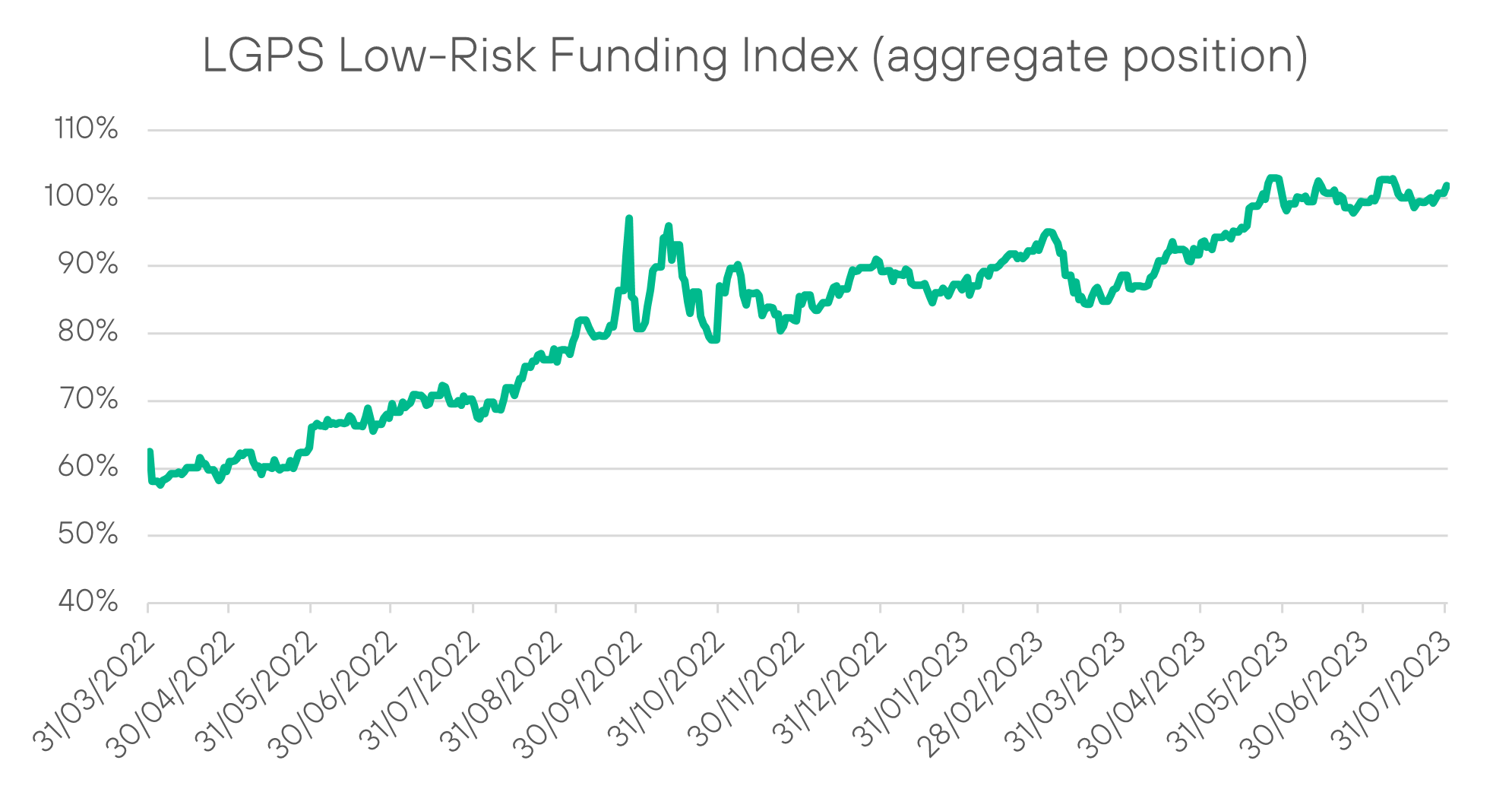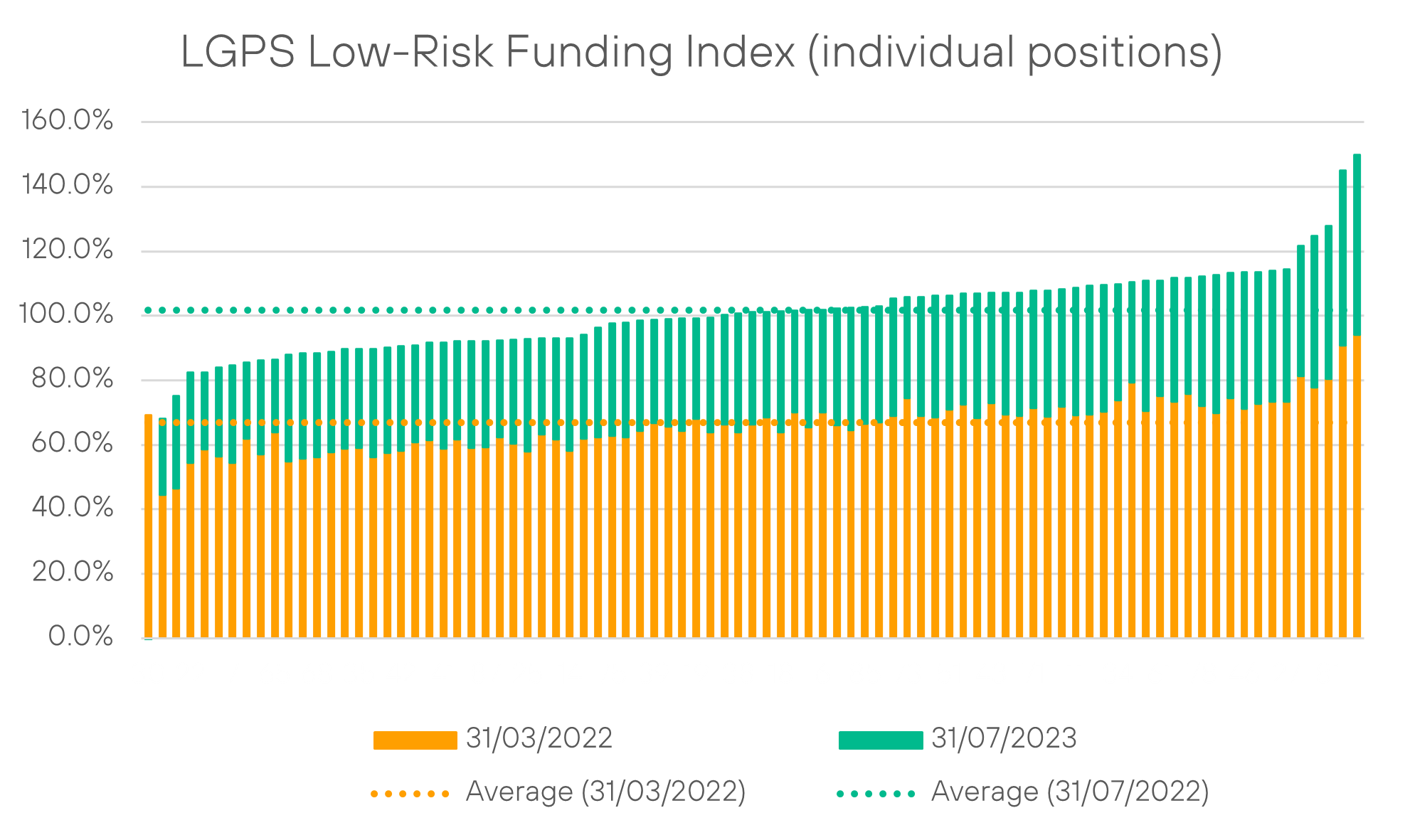LGPS (E&W) Low-Risk Funding Index: 31 July 2023 results
Pensions
Introduction
This update sets out the latest funding position for the LGPS (E&W) in aggregate.
The estimates have been carried out as at 31 July 2023 and assume a ‘low-risk’ funding basis for the liabilities, i.e. the basis that would apply if assets were fully invested in liquid, low-risk investments, such as government bonds.
The aggregate funding position has been calculated by combining the individual results for each of the 87 pension funds participating within the LGPS (E&W). A summary of the individual results is set out within this update, on an anonymised basis, but will be provided on a named fund basis in a future release.
Please note that the numerical information set out within the update has been calculated using approximate methods, based on information available within the public domain, and has been provided for information purposes only. It should not be considered as advice or be relied upon in making any financial decisions. Further information is detailed in the Appendix linked below.
Background and purpose
Market conditions for pension schemes have improved significantly since the most recent LGPS (E&W) actuarial valuations were carried out as at 31 March 2022. The value of liabilities assessed with reference to gilt yields has fallen dramatically. This has led to material improvements in funding levels for funds and their employers, and indicates that funds should:
- Consider their funding and investment objectives in light of significantly improved funding levels (these may differ when levels are approaching or exceeding 100%)
- Actively review investment strategies, specifically considering whether de-risking opportunities should be taken advantage of
- Consider whether certified employer contributions should be reduced before 1 April 2026 to avoid overfunding
- Recognise the differing needs of their employer base and enable their participating employers to agree funding and investment arrangements that reduce current contribution rates and/or ongoing risk exposure
The purpose of providing this update is to:
- Highlight the very significant funding improvements experienced since 31 March 2022
- Launch the ‘LGPS (E&W) – Low-Risk Funding Index’ – updates will be provided on a monthly basis to track the evolving funding position and the impact of changes in market conditions
- Monitor funds’ responses to these improved funding positions, considering investment strategy and employer engagement
Current market conditions are very good news for the LGPS and present an immediate opportunity to enhance long-term sustainability for funds and their employers.
Executive summary
- As at 31 July 2023, the aggregate funding level for the LGPS (E&W) was 102% funded on a low-risk basis
- The aggregate funding level has steadily increased from 67% at 31 March 2022 and has remained at broadly similar levels since 31 May 2023
- The improvement in funding level is largely due to the significant increase in UK Government gilt yields, as asset values have remained reasonably stable
- Of the 87 funds, 46 have funding levels greater than 100% and 41 have funding levels less than 100%
- The range of funding levels varies from 150% down to 68%

Next steps
Overall, based on the sustained improvement in funding levels, we would expect to see funds consider:
- Shifting to lower risk investment strategies, for example through increased exposure to gilts and bonds;
- Reviewing current employer contribution rates, in particular, whether it might be appropriate to reduce current rates; and
- Offering de-risking opportunities and other flexibilities to employers
Aggregate results
We show below the change in funding level over the period from 31 March 2022 to 31 July 2023 for the LGPS (E&W) in aggregate.

High-level commentary:
- The funding level for the LGPS (E&W) in aggregate as at 31 March 2022 was approximately 67% when calculating liabilities on a low-risk basis
- Over the period to 31 July 2023, the aggregate funding level has increased to 102%
- The improvement is largely due to changes in market conditions, in particular the significant increase in UK Government gilt yields, as asset values have remained reasonably stable
- Significant volatility was experienced in September 2022 due to the release of the UK Government’s Mini-budget
- Since the Mini-budget, the aggregate funding level has remained consistently higher than as at 31 March 2022 (an average of 93% with an upward trend), allowing funds to reasonably consider the 4 points listed at the top of this article
Individual results
The table below details the change in funding level from 31 March 2022 to 31 July 2023 for all funds who participate within the LGPS (E&W). The chart also sets out the average funding levels at each of the two dates. The results have been set out on an anonymised basis.

High-level commentary:
- 61 of the 87 funds reported a funding level of 100% or higher as part of the most recent LGPS (E&W) actuarial valuations that were carried out as at 31 March 2022. The liabilities associated with these results were calculated on each fund’s ‘ongoing’ basis
- Due to the market changes discussed earlier in this update, the reported funding levels are expected to have increased significantly over the period to 31 July 2023. Given the different approaches taken by each of the actuarial advisers to set each of the fund’s ‘ongoing’ basis, and the limited transparency, we are not able to quantify the size of the improvement
- None of the 87 funds had a funding level of 100% or higher as at 31 March 2022 when assessing the liabilities on a low-risk basis
- As at 31 July 2023, 46 of the funds have a funding level of 100% or higher on the low-risk basis
- Each fund’s funding level on the low-risk basis has increased by at least 30% over the period 31 March 2022 to 31 July 2023, apart from the Environment Agency (Closed) Pension Fund
- As mentioned above, significant improvements will also be made to funding levels on the ongoing basis, which is often used to set contribution rate levels for employers
Main observations
- Trust-based pension schemes fully funded on a low-risk basis are, with very few exceptions, transitioning to lower risk investment strategies as quickly as possible
- De-risking does not have to be permanent and it does not need to apply to future service
- We expect DLUHC and the LGPS SAB to monitor these changes and consider whether more widespread action is required (e.g. an out of cycle actuarial valuation to prevent overfunding)
- We hope that funds will consider the 4 points listed at the top of this article and take effective action to accurately reflect the prolonged significant improvement in funding levels
Engagement with funds
This update has been prepared using information available within the public domain and our calculations are estimate in nature (see the Appendix for further information).
If you are a participating LGPS fund and would like to speak to an Isio representative to discuss the information set out within this update or to provide more accurate and up-to-date information, please contact: steve.simkins@isio.com
Reliances and limitations
The numerical information set out within the update has been calculated using approximate methods and has been provided for information purposes only, it should not be considered as advice or be relied upon in making any financial decisions.
This work is compliant with the Technical Actuarial Standard TAS 100 published by the Financial Reporting Council, so far as their requirements are material for this.
Contact details
If you would like to speak to an Isio representative to discuss the information set out within this update, please contact: steve.simkins@isio.com.
Get in touch
Talk to us today to see how our bolder thinking can get you better results.
